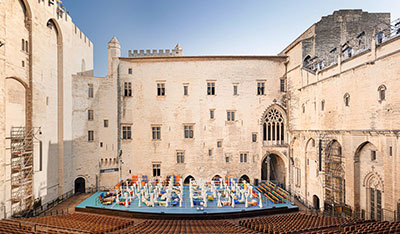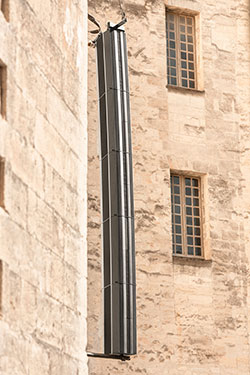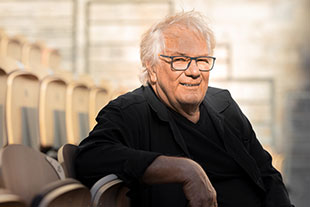![]() The Festival d’Avignon has recently completed a long-term project of major stage and technical infrastructure upgrades for its main presentation area, the Courtyard of Honor at the Palace of the Popes.
The Festival d’Avignon has recently completed a long-term project of major stage and technical infrastructure upgrades for its main presentation area, the Courtyard of Honor at the Palace of the Popes.
The work includes new 2,000-seat bleachers, a new stage, and new audio, video, and lighting – only the sixth renovation project since the festival was founded several decades ago. The project includes Amadeus and Holophonix spatialisation.
This new system replaces the previous sound setup, designed by André Serré in 2002, which comprised 2,000 loudspeakers for vocal sound reinforcement, multiple assemblies and disassemblies, temperature, storage, and operating conditions having taken their toll on the equipment’s endurance.
‘Under the growing influence of cinema, the work of actors on theatre stages has evolved considerably over the past 50 or 60 years,’ says says Félix Lefebvre, scenographer for the Courtyard of Honor and co-founder of technical scenography specialist Kanju. ‘But if actors are now almost always equipped with microphones, are we – as spectators – obliged to suffer the sound of voices whose depth, and spatial nuances seem to have disappeared in favour of a certain form of monophony?’
 The upgrade is the result of two years’ effort from different trades and specialisma. Over the same period, Amadeus designed and manufactured an audio system combining the largest long-reach ‘soundbar’ ever built (almost 30m long) with two 4m-long line-source columns. This system is to be installed each summer in the Courtyard of Honor and is complemented by a high-precision tracking system provided by the Théâtre National de Chaillot.
The upgrade is the result of two years’ effort from different trades and specialisma. Over the same period, Amadeus designed and manufactured an audio system combining the largest long-reach ‘soundbar’ ever built (almost 30m long) with two 4m-long line-source columns. This system is to be installed each summer in the Courtyard of Honor and is complemented by a high-precision tracking system provided by the Théâtre National de Chaillot.
‘All our Amadeus and Holophonix know-how combine in this unique and futuristic project, with an augmented sound dimension, confirming the technological revolutions in the world of live performance,’ says Amadeus Chairman and founder of Holophonix, Gaetan Byk.
Every aspect of the new sound system is controlled by a Holophonix 128 spatialisation processor– with many of its algorithmic optimisations developed specifically for the Courtyard of Honor at Avignon. With Holophonix now available in a software app, these developments are accessible to all, including optimisations for very large front fill systems, calculation of gain and delay values in real-time, a new parameter called LSO (Large Stage Optimizer) designed to optimize intelligibility for spectators close to the front-fill loudspeakers, and the ability to process stereophonic systems in Wave Field Synthesis (WFS).
‘The Courtyard of Honor’s problem with voice reinforcement is unique,’ says Théâtre National de Chaillot Sound Department Director Marc Piera, an expert of this type of system and the instigator of numerous algorithmic developments, who was called upon for on-site calibration in Avignon. ‘The distances – the bleachers’ dimensions, the stage width – are so large that time management problems appear, beyond simple coverage homogeneity
 To maximise spatial coherence and the spectators’ ability to locate the sound of actors and musicians on stage, a very large-format front-fill system – a ‘sound ramp’ – has been designed and installed along the length of the front stage lip. This 30m-long system includes 40 diffusion points split into 20 sound ramp modules, designed and made to measure by Amadeus in coordination with the festival team and the Kanju.
To maximise spatial coherence and the spectators’ ability to locate the sound of actors and musicians on stage, a very large-format front-fill system – a ‘sound ramp’ – has been designed and installed along the length of the front stage lip. This 30m-long system includes 40 diffusion points split into 20 sound ramp modules, designed and made to measure by Amadeus in coordination with the festival team and the Kanju.
Each sound ramp module includes two passive sections, each comprising two 5.25-inch woofers and a 1.75-inch coil tweeter. These are mounted in MTM configuration with a double waveguide located in front of the motor, designed to channel the midrange energy equally, helping to regulate the off-axis respons.
This MTM configuration has a lobe in the horizontal axis, such that the directivity grows progressively from 60° in the upper section to 100° in the lower section to optimise close-field coverage. The lobe narrows in the upper section to maximize reach at the top of the bleachers’ seating.
‘This sound ramp had to cover the first third of the tier, bur surprised us with its reach when it was first installed,’ says Amadeus R&D Director, Michel Deluc. ‘We measured an attenuation of just 15dB between the first and last rows of the bleachers, so the ramp contribution is still audible in the control room. Moreover, this attenuation is very homogeneous in spectral/frequential terms, with a small natural gain between 2kHz and 5kHz with distance, favouring intelligibility, particularly for voices.’
The sound ramp modules are powered by five Powersoft Ottocanali 4K4 DSP+Dante amplifiers, delivering a maximum of 40 500W channels.
Despite the range of the sound ramp on the stage, a longer-range, broadband system was needed to extend the frequency response in the low end and to complete the coverage in the upper half of the bleachers. Given the architectural and technical constraints of the venue, a loudspeaker system suspended above the stage complimenting the front-fill system was unrealistic.
Instead, an LR system suspended in the courtyard and the garden complements the stage system. In consultation with the Festival d’Avignon’s Technical Department, Amadeus developed a series of high-fidelity line-source modules, named the Colonnes d’Avignon (Avignon Columns). Each is 800mm high and 280mm wide, and houses 14 transducers, including four 6.5-inch long-excursion loudspeakers – co-developed with the Danish brand Purifi – as well as four planar ribbons and six 8-inch diameter long-excursion passive radiators.
 ‘This system offers a masterly combination of smoothness, response, precision, and reach,’ says Deluc. ‘The spectral response – naturally extended to 45Hz without any additional equalisation – is quite remarkable, as it is perfectly in-phase and requires no additional reinforcement for the vast majority of musical messages.’
‘This system offers a masterly combination of smoothness, response, precision, and reach,’ says Deluc. ‘The spectral response – naturally extended to 45Hz without any additional equalisation – is quite remarkable, as it is perfectly in-phase and requires no additional reinforcement for the vast majority of musical messages.’
For sound effects requiring an extended response below 45Hz, four L-Acoustics SB 28 subwoofers (inherited from the previous system) are located under the bleachers.
‘The off-axis response above 600Hz, measured on site, is within ±1.5dB, which is quite exceptional given the acoustic characteristics of the venue, the specular reflections on the walls, and the reverberation time of more than 3s on average,’ Piera says. ‘What’s more, the length of each line – around 4m corresponding to a wavelength of 85Hz – favours a directivity effect and the natural range of the bass. The feeling of precision in the lower end of the spectrum is therefore noticeable and appreciable, even at 30m and in totally uncontrolled acoustics
The nominal directivity of a loudspeaker in the horizontal plane is 100° on average and only 1° in the vertical plane. Each loudspeaker, therefore, incorporates four internal sections, each with an inter-element angulation of 0.25°, offering exceptionally precise coverage.
The production version of the Colonnes d’Avignon will be added to the Amadeus catalogue in September 2023, engineered using the developments carried out for the Festival d’Avignon.













